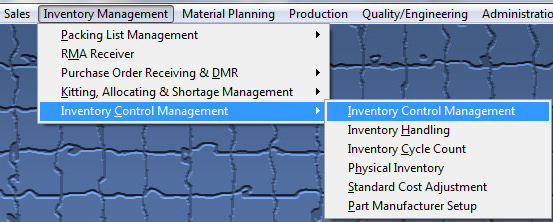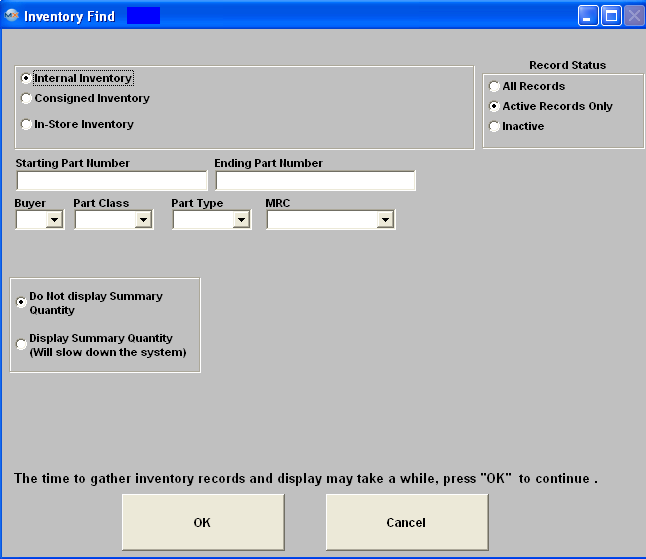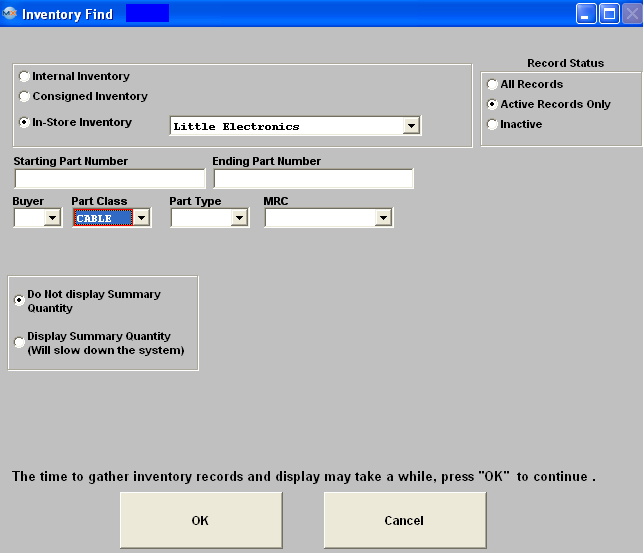|
Enter the SQLMANEX.EXE (within the ManEx root directory)
This action will then prompt the user for a password
|
 |
|
The following screen will be displayed, select Inventory Management/Inventory Control Managment/Inventory Control Management.
|
 |
The following screen will be displayed:
Inventory Find Prerequistes
In order to Find items with certain characteristics or parameters using the Inventory Find Screen, the items must have been entered in the Item Master with those characteristics. Listed below are the pre-requisites for doing 3 different kinds of Inventory Finds:
- Internal items must be in the system to be found.Searches for parts between a Starting number and Ending Part Number must include the prefix and any dashes or special characters.
- A part cannot be found in an “In-Store part find” unless it has been set up with an In-Store warehouse and supplier in the Item Master Quantity Info. screen.
- A Consigned record cannot be found for an item until the Customer has been entered and the item has been given a Customer Part No. in the Item Master Customer Reference screen.
When the user does an Inventory Find, in order to speed up the process the user may eliminate the quantity display.
Depress the Find button. The following screen will display:

Note that the default is for the Summary screen to NOT display the quantity.
If the user wants to have the quantity display on the Summary screen, highlight the desired part number and right click your mouse. The quantity will display for the one part number:
If the user wants the entire summary screen to display all of the quantities, then select the Display Summary Quantity radio button.
Inventory Find Search Field Definitions
- Internal Inventory – Products, Parts and Assemblies purchased, received, stocked, issued and shipped using standard in-house internal item numbers. These numbers are required and serve as the basis for creation of Consigned and In-Store parts. Just clicking on OK with the default selections shown in the preceding Find Screen will bring up all Active internal inventory parts in the Item Master Summary screen.
- Consigned Inventory – these records are created every time a Customer Part Number is entered in the Item Master Customer Reference screen. These records are used to enter Customer requirements (Approved Vendor List) and preferences (choices within the Approved Vendor List) for Manufacturers for a given Part Number.It is also where Customer-owned item inventory levels and locations can be seen.
- In-Store Inventory – any internal item can be setup with an In-Store Inventory for a Supplier under contract to supply that item. In-Store items are setup in the Internal Inventory Item Master Quantity Info screen and can be viewed individually in that screen or as a group by supplier in the Summary Screen as the result of an Inventory Find by In-Store Inventory.
- Starting Part Number and an Ending Part Number
- Enter all prefixes, dashes, spaces and alpha characters to show the entire number.
- Enter first and last Part Number of a series for those and all items numbered between.
- Enter a desired single item in the 1st box and hit return to select only that record.
- Assigned Buyer will bring up all items assigned to that particular Inventory Buyer.The Buyer assignment is made in Part Class and Type System Setup Defaults or in the Item Master.
- Part Class and/or Part Type will bring up only those items that match all entries made.Both Part Class and Part Type must be specified to bring up any items.
- Do not display Summary Quantity radio will by-pass the quantity calculation.
- Display Summary Quantity radio will open up another selection "Total On Hand Quantities"
- Total On Hand Quantities will bring up only items with matching inventory quantities.The user may choose from Total Quantity on Hand, Quantity on Hand > 0, or Quantity on Hand = 0.
- Record Status allows selection of All, Active Only or Inactive Only item records.
Tips on Using the Inventory Find Screen
- Selection of at least one parameter will reduce the time to retrieve the information.
- In-Store Inventory searches require that a Contract be entered in order to select a Supplier. (Please refer to Manex / Material Planning / Purchase Setup / Supplier Contract Management and the Supplier Management manual).
- Consigned Inventory searches show Customer-specific information (such as Approved Vendor List information) as well as Consigned Inventory On-Hand Quantities.
- If no information is selected in a Find operation, try using broader or fewer selection criteria.
Combination Searches
Combinations of search parameters may be made for further filtering of the Inventory Item Master files to see item(s) of interest. For instance, selecting the items on the example screen will find all ACTIVE, In-Store Inventory for "Little Electronics" with the Class “CABLE”.In-Store Inventory Searches are Supplier specific whereas Consigned Inventory searches require entry of a Customer in order to initiate the search.
If user selects to find "Internal Inventory" "All Records" they will get the following message "You must enter a search criteria in addition to "All Records" selected in the "Record Status" radio button. This is because the inventory file may be very large so the user is encouraged to narrow down their selection. If they want all they will need
to narrow it down by another criteria, or the system will take way too long to to bring the screen up and put a burden on the network and the SQL server.
Inventory Find Example
The screen shown below is to illustrate Inventory Find results from selecting Internal Inventory, a Part Class of CAP-SMT, a type of 0805, Total On Hand Quantities of Qty on Hand = 0, and Record Status of Active Records Only

The first tab (Summary Tab) is used to display the results of an Inventory Find. The remaining Tabs will then display detail information for any item selected (highlighted) in the Summary screen. If no items have yet been entered in the system or copying an existing part is not needed, it is not necessary to populate the Summary screen by doing an Inventory Find.
If user has the internal inventory screen open as well as the customers inventory screen open, the customer name will be displayed at the top of the page. So when switching between the two screens user will easily be able to determine which screen they are in.

| 






